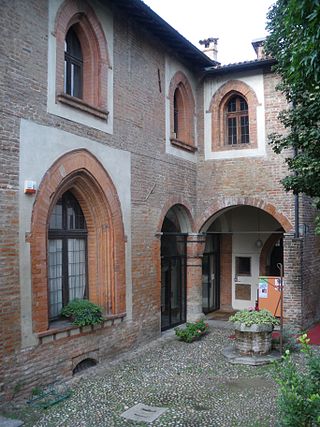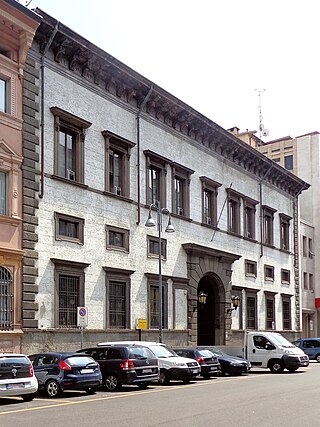History and description
The palace was built by Luigi Dal Verme (1390—1449), count of Sanguinetto, in the middle of the 15th century on land in the Contrada of San Giovanni sul muro donated by the Dukes of Milan. [1] I Dal Verme began his career as a condottiere in the service of Conte di Carmagnola, whose daughter, Luchina Bussone, he married. He was then a captain of fortune under the insignia of Filippo Maria Visconti, from whom he obtained the fiefs of Bobbio and Voghera, and after the latter's death fought alongside Francesco Sforza. [2] The construction was then continued by his son Pietro and grandson Federico.
The complex, which survived in good condition until the 20th century, was badly hit by bombs in 1943, which destroyed its façade. The courtyard survives today, as part of a modern post-war condominium complex.
The courtyard is accessed through an entrance hall, which features the original Renaissance decoration consisting of frescoes covering the cross vaults, supported by carved corbels. The regular courtyard is opened by porticoes on the four sides of four arches each. The arches are supported by stone columns surmounted by composite capitals with acanthus leaves, which house horse-head plaques with coats of arms that are no longer legible. Above the arches runs a decoration of terracotta cornices and cords, restored to their surviving parts. Between the spandrels of the arches, a series of stone roundels alternates noble coats of arms with profiles of personages from the Sforza court. [3] In the centre, a sculpted well-curb, dating back to the 15th century.

Vermezzo is a comune (municipality) in the Metropolitan City of Milan in the Italian region Lombardy, located about 15 kilometres (9 mi) southwest of Milan.
Lucrezia Landriani was the mistress of Galeazzo Maria Sforza, Duke of Milan, and the mother of his renowned illegitimate daughter, Caterina Sforza, Lady of Imola, Countess of Forlì. Lucrezia had three other children by the Duke, and two by her husband.

Sante I Bentivoglio was an Italian nobleman who ruled as tyrant or de facto prince of Bologna from 1445 to 1462.

Vito D'Anna was an Italian painter, considered the most prominent painter of Palermitan rococo and one of the most important artists of Sicily.

Luigi Busi was an Italian painter born in Bologna.

Luigi da Rios was an Italian painter.

Luigi Catani is an Italian painter of frescoes during the neoclassical period, active in Tuscany.

Gustavo Frizzoni was an Italian art critic and art historian.

The Arese are a prominent family of the Milanese nobility.

The Visconti Castle of Pavia is a medieval castle in Pavia, Lombardy, Northern Italy. It was built after 1360 in a few years by Galeazzo II Visconti, Lord of Milan, and used as a sovereign residence by him and his son Gian Galeazzo, first duke of Milan. Its wide dimensions induced Petrarch, who visited Pavia in the fall of 1365, to call it "an enormous palace in the citadel, a truly remarkable and costly structure". Adjacent to the castle, the Visconti created a vast walled park that reached the Certosa di Pavia, a Carthusian monastery founded in 1396 by the Visconti as well and located about 7 kilometres (4.3 mi) to the north.

The Casa degli Eustachi is a medieval palace in Pavia in Lombardy.

Palazzo Cornazzani is a palace in Pavia, in Lombardy, where, between 1895 and 1896, Albert Einstein lived.

The Casa dei Grifi is a historic building in Milan, located in Via Valpetrosa 5.

Villa Simonetta is a villa Renaissance located in Milan at Via Stilicone 36, built at the end of the 15th century and then enlarged and renovated several times. Today, the villa is municipal property and is home to the Civica Scuola di Musica «Claudio Abbado».

Palazzo Carmagnola is a palazzo quattrocentesco in Milano, which was remodelled several times in the following centuries. Historically belonging to the Sestiere di Porta Comasina, it is located in via Rovello 2.

Palazzo Isimbardi, also palazzo della Provincia, is a historic building in Milan located at 35 Corso Monforte, the seat of the Metropolitan City of Milan.

Palazzo Spinola is a 16th-century palazzo in Milan, heavily remodelled during the 19th century. Historically belonging to the sestiere di Porta Nuova, it is located at 10 Via San Paolo. Since 1808 it has been the seat of the Garden Society.

Palazzo Visconti di Grazzano, also known as Palazzo Visconti di Modrone or Palazzo Bolagnos, is a historical palace located in the centre of Milan, in Via Cino del Duca no. 8.

Casa Atellani, or also Casa degli Atellani, is a demorial that belonged to Ludovico Sforza, Duke of Milan, the last surviving trace of the ancient Borgo delle Grazie. Historically part of the Sestiere di Porta Vercellina, today it is located at numbers 66 and 67 of Corso Magenta. It was owned by the Castellini Baldissera family.
This page is based on this
Wikipedia article Text is available under the
CC BY-SA 4.0 license; additional terms may apply.
Images, videos and audio are available under their respective licenses.




























